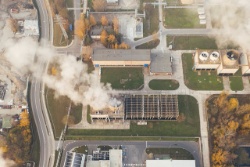Malian Aero Company Uses Spidertracks for Cloud-Seeding
New Zealand Company Bringing Water to Africa: How Malian Aero Company Uses Spidertracks in its Vital Cloud-Seeding Operations
Rain is essential to human life on Earth
— but climate change has made it impossible for areas that
once received sufficient water to thrive. In Africa,
Mali-based Malian Aero Company (MAC) has become the
undisputed leader in the primary technique used to combat
this destructive dryness: cloud-seeding.
During cloud-seeding, clouds are treated with microscopic particles (ice-forming or hygroscopic) that interact with the water vapour in the clouds, producing droplets that enhance rainfall. Treating clouds is an often-dangerous process that requires pilots to fly into suboptimal conditions to get maximum rain results.
MAC’s cloud-seeding operations run during the rainy season — from June to October — in accordance with Sanji, the government’s rain enhancement program. Sanji has been functioning for 10 years and has seen ‘excellent results,’ according to MAC Manager of Cloud Modification Gallie Van der Hoven, who notes that two independent studies have shown an 8% increase in rainfall during the last 10 years of cloud-seeding over the 20 preceding years of non-seeding.
‘A cloud-seeding operation runs counter to normal aviation rules,’ says Van der Hoven. ‘Typically, pilots learn to avoid storms they encounter by going around them. But as soon as we see a storm, our trained pilots are ordered to go exactly there — into the danger zone!’
So how does MAC track its aircraft and ensure its pilots’ safety in these conditions?
Spidertracks.
MAC has four Spiders, two of which it uses for cloud-seeding. The cloud-seeding units sit in MAC’s government-supplied Beechcraft B200s and provide the company with the tracking capabilities and information they need to keep their pilots out of harm’s way.
The system that MAC had been using before Spidertracks presented problems whenever the aircraft flew into storms and outside line-of-sight of the control center. ‘Safety of the pilots is our first priority,’ Van der Hoven says. ‘Previously, we sometimes lost track of the aircraft at critical times, making it harder to keep them safe from hazardous situations.’
After doing extensive research into the available tracking options, MAC chose Spidertracks. Now, they have the ability to see where their aircraft are and what they’re doing regardless of whether or not the pilot’s in range of the control center.
‘Our pilots and aircraft are hammered under severe turbulence during these flights,’ Van der Hoven notes. ‘It’s absolutely vital to always know exactly where they are — and the Spiders provide us with this information.’
To learn more about MAC’s cloud-seeding efforts and how they’re slowing the desertification of the Sahara, visit mac-mali.com.
ENDS


 Stats NZ: Greenhouse Gas Emissions Fall 2.0 Percent In The December 2024 Quarter
Stats NZ: Greenhouse Gas Emissions Fall 2.0 Percent In The December 2024 Quarter The Reserve Bank of New Zealand: Christian Hawkesby Appointed As Governor Of The RBNZ
The Reserve Bank of New Zealand: Christian Hawkesby Appointed As Governor Of The RBNZ Kiwi Economics: It’s Mayhem In Markets As Downside Risks Dominate Following Trump’s Tariffs
Kiwi Economics: It’s Mayhem In Markets As Downside Risks Dominate Following Trump’s Tariffs Mindful Money: Consumer Demand For Ethical Investing Remains Strong Despite International Headwinds
Mindful Money: Consumer Demand For Ethical Investing Remains Strong Despite International Headwinds Greenpeace: Taranaki - Greenpeace Activists Stop Unloading Of Palm Kernel Sourced From Indonesian Rainforests
Greenpeace: Taranaki - Greenpeace Activists Stop Unloading Of Palm Kernel Sourced From Indonesian Rainforests Seafood New Zealand: Seafood Situation Saved By A Sausage - New Plymouth Locals Innovate, Using Crayfish Bait
Seafood New Zealand: Seafood Situation Saved By A Sausage - New Plymouth Locals Innovate, Using Crayfish Bait



